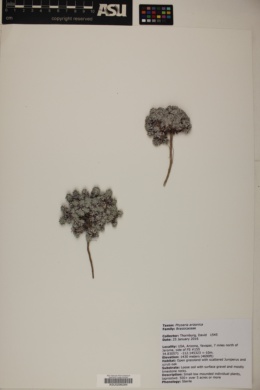Physaria arizonica
|
|
|
|
Family: Brassicaceae
Arizona Bladderpod
[Lesquerella arizonica S. Wats., moreLesquerella arizonica var. nudicaulis Payson, Physaria arizonica var. andrusensis] |
Perennials; caudex branched, (cespitose); densely (silvery gray) pubescent, trichomes (sessile or subsessile), (4-), 6-, or 8-rayed, rays fused at base, furcate or bifurcate, (slightly umbonate, tuberculate throughout). Stems simple or few to several from base, erect, (unbranched, slender), 0.2-1(-1.5) dm. Basal leaves (densely tufted, not rosulate, reflexed in age); blade obovate to oblanceolate, 0.7-2(-3) cm, margins usually entire, sometimes repand or shallowly dentate, (apex acute). Cauline leaves similar to basal, becoming narrower distally, somewhat reflexed, (distal) blade linear or narrowly oblanceolate, 0.5-2.5(-5.5) cm. Racemes dense, often subcorymbiform. Fruiting pedicels (erect or divaricate-spreading, straight or slightly curved), (3-)5-10(-15) mm. Flowers: sepals (green or greenish yellow), ovate or broadly ovate, 3.5-6.5 mm, (lateral pair subsaccate, cucullate, median pair thickened, slightly cucullate apically); petals (spreading), oblanceolate to obovate, 5.5-8(-10) mm, (claw erect). Fruits (sessile or substipitate), suborbicular to ovoid or ellipsoid, slightly inflated, 4-7 mm; valves pubescent outside, trichomes substipitate, spreading, sometimes sparsely pubescent inside, trichomes sessile, smooth; ovules 4-10(-16) per ovary; style (0.5-)1-2(-4) mm (shorter than fruit). Seeds flattened. 2n = 10. Flowering Apr-Jun. Sandy and gravelly soils, limey knolls or limestone chip, often in open stands of sagebrush-pinyon, pinyon-juniper, Gambel oak and sometimes ponderosa pine; 1000-2200 m; Ariz., Utah. The circumscription of Physaria arizonica here is quite broad and includes plants that have densely tufted basal leaves and relatively few or no cauline leaves; plants that are loosely tufted and have several cauline leaves; and plants that have a strongly branched caudex, leafy stems, and sterile shoots (var. andrusensis). Additional study is needed to understand the pattern of variation in this complex species; all of the characters given above vary considerably.
FNA 2010, Kearney and Peebles 1969, McDougall 1973 Duration: Perennial Nativity: Native Lifeform: Forb/Herb General: Herbaceous perennials, to 15 cm tall, stems simple or branching from the base, herbage silvery gray and densely pubescent, trichomes with up to 8 rays fused at the base, plant arising from a woody caudex. Leaves: Alternate, basal and cauline; basal leaves not in a rosette, obovate to oblanceolate, 1-3 cm long, densely tufted, becoming reflexed in age, margins entire, wavy, or shallowly dentate, acute at the tips, cauline leaves becoming reduced distally, linear or narrowly oblanceolate, 0.5-5.5 cm long, somewhat reflexed. Flowers: Showy with bright yellow, spreading petals, these 5.5-8 mm long, oblanceolate to ovate, with an erect claw, sepals green or greenish yellow, 3.5-6.5 mm, ovate or broadly ovate, the lateral pair with a small sac near the base, hooded, median pair thickened, slightly hooded at the tips, flowers borne in dense, subcorymbiform arrays at branch tips. Fruits: Inflated globose or ovoid to ellipsoid capsules, 4-7 mm long, valves pubescent outside, sometimes sparsely pubescent inside, trichomes sessile. Seeds flattened. Ecology: Found on rocky slopes and mesas, from 3,500-7,000 ft (1067-2134 m); flowering April-May. Distribution: Utah, Arizona. Notes: The bright yellow, fragrant flowers make this plant stand out when in flower. According to FNA this species is found in northern Arizona and southern Utah, and Kearney and Peebles note that this species integrades freely with L. intermedia. Ethnobotany: There is no use recorded for this species, but other species in this genus have uses. Synonyms: Lesquerella arizonica, Linnaeus arizonica var. nudicaulis, Physaria arizonica var. andrusensis Editor: LCrumbacher 2012 Etymology: Physaria comes from the Greek phusa or physa, "bellows" because of the inflated pod, while arizonica means of or from Arizona. |
|
|
|












































































